Sarah Palin’s use of “blood libel” today, as is already clear to most people, is divorced from the historical origins of the term. But it’s worth taking a moment to revisit the original meaning of the phrase and the violent context from which it emerged.
I called Ronnie Hsia, a history professor at Penn State who has written extensively on blood libel and early modern Europe. He explained that the term generally refers to the medieval “fantasy in Christian belief that Jewish communities needed Christian blood for Passover.”
“It was based on an ignorance and fear of Jewish rituals on the part of Christians and also the Christian fixation on blood,” he says. Most often, it would be the blood of a child; thus, the idea often surfaced after the murder or abduction of a child.
The myth came up in different places, including Christian theological writings, folk tales and legends. From time to time, accusations would be made against Jews after specific incidents, and trials would be held. Sometimes they ended with executions. Sometimes the accused Jew would be tortured into confessing. The first documented case of a blood libel, which was also known to Christians as “ritual murder,” was in the 12th century.
Perhaps the most famous blood libel occurred in 1475 in Trent in northern Italy, a case that is the subject of a monograph by Hsia. He summarized the case in an article a few years ago:
On Easter Sunday 1475, the dead body of a 2-year-old Christian boy named Simon was found in the cellar of a Jewish family’s house in Trent, Italy. Town magistrates arrested 18 Jewish men and five Jewish women on the charge of ritual murder – the killing of a Christian child in order to use his blood in Jewish religious rites. In a series of interrogations that involved liberal use of judicial torture, the magistrates obtained the confessions of the Jewish men. Eight were executed in late June, and another committed suicide in jail.
The boy, Simon of Trent, was later named a martyr by the Catholic Church, a designation that was rescinded only after Vatican II in 1965.
Those executions in Italy occurred in the middle of the period of highest prevalence of the blood libel: the 14th to the 17th century. “Christian Europe was undergoing a great deal of crisis and anxiety,” Hsia says, citing the Protestant reformation that divided Christianity as well as the advance of the Ottomans, among other factors.


